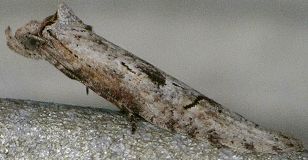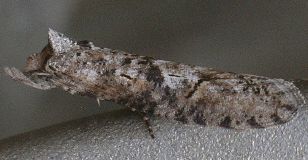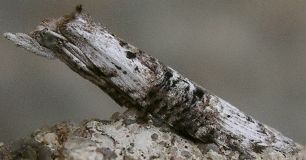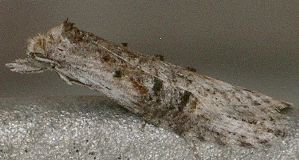
| Copromorphidae ~ Tropical Fruitworm Moths |
|
There are two small species that regularly appear in the spring but are easy to overlook, partly due to their habit of resting on surfaces with colors matching their wings. The only genus of Copromorphidae that we have represented in our area is Ellabella. I think the Latin name is so fetching that no other common name need be given. These moths somewhat resemble tortricids, but their unique posture when resting makes identification relatively easy considering their diminutive size. They will rarely move if you nudge or otherwise disturb them. After all, a twig would not move, would it? That's exactly what they are mimicking. If knocked off their perch, they simply lie there, looking just like a bit of debris.
Ellabella melanoclista is present from the beginning of January through the end of February. This species is about 10 mm in length, with slightly variable colors. It is often attracted to lights. Beginning at the end of February and continuing through March, Ellabella editha is the species seen. This moth tends to be a millimeter or so smaller (wow, BIG difference), which doesn't help a whole lot with distinguishing them. However, upon close inspection, it can be separated from its cousin by markings. E. melanoclista always has three thin black streaks on each wing, which remain visible even on worn specimens, while E. editha lacks the streaks and instead has three raised black bumps. If these are not obvious, E. editha also has large light-colored patches on the shoulders. |
![]()



